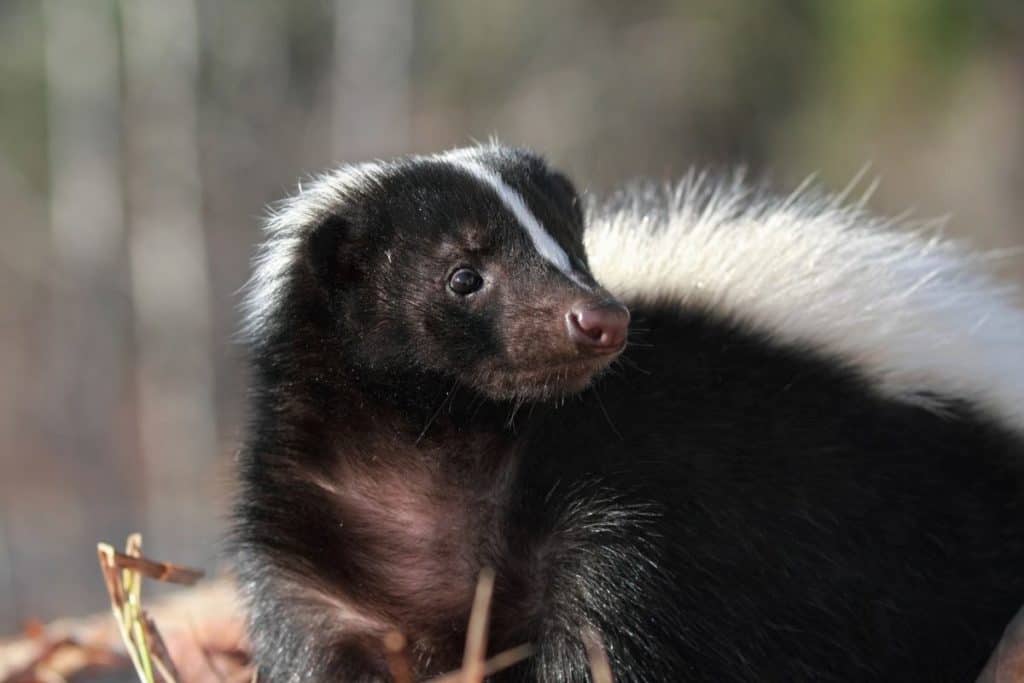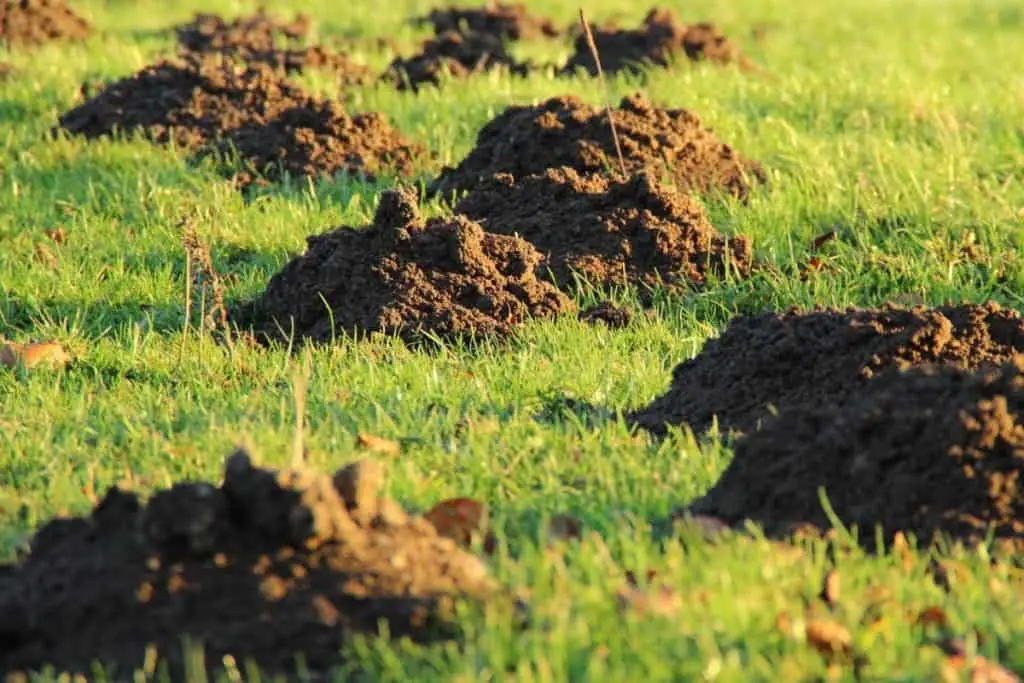1) Skunks

Skunks are one of the most frequent offenders of digging up your pristine yard which you have spent endless hours slaving over. They are also one of the most unwanted animals as they not only destroy a yard but can spray pets and generally cause an unpleasant outdoor experience. Skunks will often move in at night and dig holes in the turf looking for grubs to eat. While the easiest way to tell if you have skunks within your neighborhood is to keep an eye out around evening until about midnight another telltale sign is the smell that skunks make when scared or alarmed.
The easiest method to keep skunks out of your yard is to prevent them from coming in the first place. There are control methods such as fences and then prevention methods such as removing what is drawing skunks in.
Skunks usually cause problems with lawns because they are looking for insect larvae. They do this by rolling the grass. To get rid of them, you should use a grub treatment like Grubex. Grubex when applied according to manufacturer directions will take away the grubs in the soil.
After that, you have essentially removed a primary food source of the skunks and they will move on to another yard that is more favorable.
2) Groundhogs
Groundhogs are another animal that is commonly known to dig holes in yards. They live in burrows underground that can range from 8 to an amazing 66 feet long!
The majority of their burrows will be located around decks, storage sheds, and homes with crawl spaces, which can lead to major damage.
They also tend to dig in areas of tall grass, where it is easier for predators to overlook the burrow. These can be especially treacherous to those walking in the area. It isn’t uncommon for humans or pets to break a leg by stepping into the entrance of a groundhog burrow.
3) Moles

Moles can cause significant harm almost immediately within your yard and are voracious diggers. Moles will create noticeable dirt mounds when they surface and will dig trails underground just under the surface which will often collapse and create paths within your yard. They also eat the roots of grass, trees, and shrubs which can create issues with your landscaping as well.
Identifying a mole infestation entails searching for volcano-shaped mounds of earth with no holes or exits that are pushed up from deep below the surface and run through the grass, usually in the shaded areas.
Moles have no real benefit to your yard, so personally, I have no qualms about using traps or other means to remove them from your property.
4) Voles
Voles burrow during the winter to stay warm, lining their tunnels with grasses from the previous fall to offer insulation and protection against predators. In preparation for the snowy months, they collect and cache seeds, tubers, and bulbs in the late summer and fall.
The earliest indication of voles is when the snow and frost cover begins to melt in the spring.
Vole tunnels are quite different from tunnels of moles. They’re tiny, usually about 1-2 inches in diameter, and typically include what looks like mouse feces. Voles will also leave runways behind on the lawn/turf’s top 2-3 inches of dirt. The constant travel of the vole will wear away the grass leaving distinct paths in your turf. They will usually fill back in with grass as the winter turns to spring or to expedite the process you could lightly overseed the area with grass seed that matches your existing turf.
Voles are food for many birds of prey, foxes, and other predators, so mowing often to reduce coverage might help keep them in check. Voles are essential components of the ecosystem since they’re hunted by a variety of raptors, foxes, and other predators, and populations fluctuate with the seasons.
5) Pocket Gophers
The smaller pocket gopher (Thomomys striatus), or commonly called a gopher is a subterranean rodent that lives in tunnels. They are a very adaptable creature and able to live in harsh conditions tolerating temperatures as low as -50 degrees Fahrenheit. Because it spends so much time underground, they are known to be a common pest around the yard causing destruction to turf grass.
Unlike the mole, the pocket gopher is an herbivore that consumes roots, bulbs, and shrubs while tunneling.
The tunnels are distinguishable by their huge crescent or fan-shaped dirt mounds with a hole plugged with earth that serves as an entrance and exit.
The most common predators for pocket gophers are snakes that will follow them underground and hawks and other birds of prey who will target them when they are above ground. Pocket gophers are also a common food source for foxes.
6) Raccoons
Raccoons are a common pest that causes damage to yards all over the country. Their diet consists mainly of fruits, nuts, berries, insects, eggs, small mammals, reptiles, amphibians, fish, carrion, garbage, bird nests, and even pet foods.
They are omnivorous animals meaning they consume both plant material and animal matter. The raccoon has been known to raid trash cans looking for leftovers.
Raccoons will commonly dig up a yard to find buried items such as grub worms, acorns, apples, potatoes, corn, carrots, turnips, onions, etc.
They can cause significant damage to landscaping plants including trees, bushes, flowers, vegetables, fruit trees, ornamental plants, and more.
To prevent raccoons one should make sure there aren’t any open trash containers with food waste kept outdoors. Also, where possible if you have pets outside make sure you are feeding them indoors.
7) Earthworms
The earthworms are actually beneficial and essential to lawns. Their burrowing activity aerates the soil and aids in the decomposition of thatch, therefore, improving air and water circulation. They’re also a crucial food source for many birds.
Although earthworms may contribute to a bumpy, lumpy lawn that is less than appealing, in the late spring you can rent or hire out a lawn roller which can help level out lawn imperfections and give you a more uniform lawn.
8) Wasps & Yellow Jackets
Wasps
Although wasps are known for their sting, they’re actually beneficial; out-of-the-way nests should be left alone. Even if they’re near to human presence, solitary wasps that dig can sting, but they generally won’t unless harmed or provoked.
Stings from solitary wasps are usually minor, but they differ from person to person. Yet, if a nest is found in an area where problems may develop because the area is frequently traveled by humans or pets you may have no other choice but to remediate it.
People often do not understand that wasps are extremely useful in controlling spiders, cicada, and other insect species.
Their stingers are primarily used to paralyze their prey and leave them in their tunnels for their offspring.
Yellow Jackets
Yellow jackets, often called ground wasps will burrow in the ground, near the edge of landscaping or on slight grade changes, creating an underground nest. Overall, they do not do much damage to lawns, but they can be hard to spot at first until you unintentionally disturb their nest and find yourself getting stung.
The best way to get rid of a yellow jacket nest is to wait until evening when they become less active and spray the outside of the nest with an approved yellow jacket insecticide or call a professional exterminator to handle the remediation.
9) Chipmunks
If your home’s landscape includes wooded areas, then chipmunk holes could appear anywhere along the perimeter of your property. These little critters love digging into soft dirt, making homes under tree roots. If you notice small piles of dirt around your house, these might indicate the presence of chipmunks.
Chipmunks are determined animals and scaring them away is usually only a temporary solution.
To get rid of chipmunks you can use rodent bait stations, poison pellets, or traps. You can also try using a non-toxic solution such as dish soap mixed with hot water.
10) Certain Snakes
Certain snakes will dig holes in your yard. Some do this to create an area to live, while others will dig and burrow to seek out tunneling creatures such as moles, voles, or gophers. One of the most common snakes to do this is the corn snake which will prey on mice and moles.
11) Armadillos
Armadillos are burrowing mammals found in North, South, and Central America. When it comes to armadillos they like to dig holes for a variety of reasons but mainly for one main reason. Their strong front claws help them dig up insects to feed on such as beetles, ants, and termites. It was previously thought that armadillos carried diseases but recent studies have shown there isn’t any evidence of this claim being true so you’ll have nothing to worry about with your armadillo neighbors.
How To Repair Animal Damage To Your Yard?
If your lawn is damaged by animals, the first thing you should do is figure out if the animal has left the area or not. There is no use spending the time and money to repair a damaged section of your lawn only to have the animal return and create additional damage.
Assuming the animal is no longer a threat to your lawn you should repair the damage as quickly as possible.
The best way to repair damaged areas in your lawn is by using sod. Sod is already sprigged with grass and treated with fertilizers, so it’s an easy way to limit the length of time the damaged area will be noticeable.
The main thing to look for with sod is that it matches your existing lawn as closely as possible.
There are some cases where it may be far more cost-effective to install a new section of sod that is a different color than the existing lawn, but you should only do this if the damaged area is small and not on display to many people passing by.
Replacing large sections of the yard with new sod can get expensive very quickly, so make sure you take your time and find out what methods will work best for repairing your damage before attempting any repairs.
If you cannot use sod, find grass seed that matches your existing lawn as close as possible. Fill any imperfections with soil, put down the seed and lightly sprinkle some peat moss to help keep the seed moist.
Continue to water the area as directed on the seed bag. Within five to twenty-five days you will see the seed begin to germinate and the area will slowly fill in.
Later you can add more seed if needed to help your lawn thicken up.
Recommended To Read Next:
Is Terro Safe For Pets? – find out if you are applying Terro to combat ants, if it will hurt your pets.
